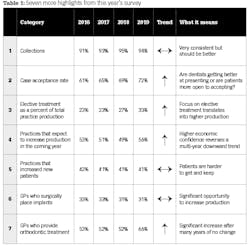It's all about production: Findings from the 2019 Dental Economics–Levin Group Annual Practice Survey
There have been countless articles, presentations, discussions, and debates in our profession recently on the various massive changes occurring in our profession. Just look back at the covers of the last dozen or two issues of Dental Economics and you will be reminded of the large-scale (some might say cataclysmic) shifts occurring in dentistry. From the skyrocketing growth of group practices to falling-off-the-cliff insurance reimbursements, and everything in between, there are plenty of game-changing dynamics at play for practicing dentists.
For all of this change, there is one constant that has persevered throughout this modern era of dentistry, and the results of this year’s Dental Economics–Levin Group Annual Practice survey only serve to reinforce it. At the end of the day, it’s all about production.
Increasing practice production has been Levin Group’s niche for more than 35 years. It has been our first and foremost focus with every one of our 30,000-plus clients. When we look at all of the factors that affect the long-term viability and success of a dental practice, the ability of a practice to consistently increase production, year after year, is the foundation upon which everything else is built. A solid base of high production allows the providers and staff in a practice to focus on:
• excellent clinical care,
• outstanding customer service,
• expanded continuing education opportunities for the doctor and team,
• excellent compensation and employee benefit packages, and
• everything else that leads to a successful and enjoyable dental practice.
Now in its 13th year, the team at the Levin Group Data Center was pleased to design the survey, collect and analyze the responses, and work with the editors at Dental Economics to bring you these important insights into our profession. Let’s look at what our colleagues had to tell us this year.
This year's data was collected between April and July 2019 from general dentists. We asked the respondents to consider 2018 practice statistics when responding to questions about practice performance, but to consider their current attitudes (as of the survey date in the second quarter of this year) when answering questions about the direction and trends of practice performance. Most respondents (94%) own their practices, and 91% of them have been in dentistry for more than 10 years, and almost half have been in the profession for more than 30 years.
Production, production, production
Practice owners appear to be re-energized to grow their businesses. When asked what strategies they were focused on for improving their practices in 2019, the vast majority of answers discussed proactive tactics aimed at increasing production and/or reducing overhead. The net result of both is higher profit. In their own words, this year’s respondents provided very business-centric answers that fall into three categories.
1. Adding new services and adding time in the schedule to perform these services.
2. Analyzing and adjusting insurance plan participation
3. Improving the management of supply inventory, (i.e., buying groups, just-in-time ordering, multiple bids, and more).
This renewed energy for increasing production seems to be bearing fruit. This year’s average total practice revenue of $1,193,934 was 11.4% higher than in 2018. The average responding practice had 1.7 dentists and 1.6 hygienists to produce this amount. Given this positive trend, it was no surprise to see that a solid majority (56.4%) of practice owners expect 2019 production to exceed 2018. That is an eight-point jump in economic confidence this year.
Some of this increased production is coming from higher percentages of elective treatment being performed by the surveyed practices. When asked how much of their practice production is derived from elective treatment, this year’s response was six points higher than in 2018 at 33.3% (which equates to approximately 19% of doctor production). As stated, doctors are adding more services and presenting more elective treatment. This is a great combination, and a very business savvy approach to generate more production for the practice.
Doctors are focused not only on increasing revenue, but also on the expense side of the equation. At 64.5%, this year’s average practice overhead has improved by two points over last year. That is real money when you consider that a 2% reduction in overhead on the reported average practice production puts $24,000 back in an owner’s pocket. Speaking of putting money in their pockets, this year’s group reported another strong year for maintaining a high collection rate, with the average practice collecting 94.1% of what they are owed. There’s definitely room for improvement in this area. Levin Group clients, for example, implement systems that enable them to reach 99% collection rates, but the survey results are identical to similar statistics from medical practices.
Dentists have adopted a new outlook on retirement
Over the past 13 annual surveys, doctors have added six years to their expected retirement age. In 2006 the average anticipated retirement age was 61.5. In this year’s survey the average age notched up yet again and now stands at 67.6 years. Interestingly, two-thirds of those taking the survey said they do not expect to delay retirement, indicating they may have already adjusted their retirement age expectations.
Social media use continues to grow
More than 80% of practices now use some form of social media to connect with patients and promote their practices. Facebook is still the most popular social site. Three-quarters of dental practices in the survey have a Facebook. Instagram has jumped to the second spot, and one in five practices use it. Fifteen percent of practices tweet, 17% use LinkedIn, and an impressive 24% provide a blog on their practice website for patients.
Bonus tip: We didn’t ask how many doctors have used the Google My Business tool to claim and manage their Google listing, but if you haven’t done this already you should take that step as soon as you can. Having an accurate Google listing might be the single most important online marketing tactic for a dental practice. When we add this question to next year’s survey, we can hopefully report very high usage.
Are more general practitioners offering orthodontics?
The answer is yes, and there is a fair amount more than last year. The number of doctors in this year’s survey who reported offering orthodontic treatment increased 27.5% in 2019 to 66.3%, and 97% of those provide clear aligners as a treatment option. This area of dentistry is highly competitive right now as many orthodontic companies are actively entering the market with large-budget advertising campaigns aimed at raising consumer awareness. More patients are asking their dentists about clear aligners in particular, and the data shows more dentists are adding this service in response.
What are some additional highlights from this year’s survey? See Table 1.
All the numbers matter, but production is the key
The Dental Economics–Levin Group Annual Practice Survey is the most comprehensive look at the important business management trends in the dental profession. We look at many practice statistics and trends. It should be encouraging to see that this year’s main theme is increasing practice production. Every business has one key measurement that will provide more insight into the business performance than any other statistic. In the case of dentistry, it is production.
Production is not the only number that should be tracked and studied; however, it is the most important. Ultimately, most other key performance indicators relate back to production.
Summary
Currently, our profession is in an excellent position. As you can see from the survey, 2018–2019 was a positive period and gives dentists a reason to be optimistic. Practices are expanding in new directions, including sleep dentistry and aligner orthodontics. Keep in mind that part of the good news found in many of these statistics can be attributed to a robust economy. In a good economy, patients are willing to visit the dentist more regularly and accept higher levels of treatment, including elective services.
Our national economy is in a nine-year upward economic run. At some point a recession will inevitably occur and as we learned in 2008–2009, dentistry is no longer recession-proof. When a recession occurs, many practices will flatten or decline in production. It is therefore critically important to continually improve practice performance so that when an inevitable slowdown occurs your practice will be protected.
Thanks again to the dedicated team of professionals at the Levin Group Data Center for asking the right questions and deriving pertinent analysis of the results. But an even bigger thank you to all dentists who took time out of their busy schedules to participate in the survey. Your valuable input will benefit our profession by providing important insights into the key measurements of dental practice in the United States.
See you again with more results in 2020!
ROGER P. LEVIN, DDS, is the chairman and CEO of Levin Group Inc., a leading dental consulting firm. A nationally recognized speaker, Dr. Levin presents practice management seminars throughout the country.

